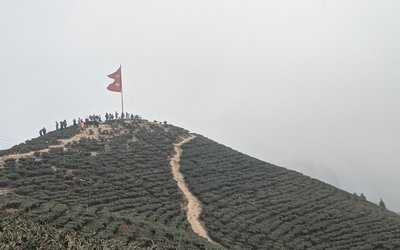
In just a week after taking the helm of the Ministry of Finance for the fifth time, Dr. Ram Sharan Mahat has a reason to rejoice: his ministry released its mid-term review with a forecast aimed at achieving the targeted economic growth of 5.5 percent for the fiscal year 2014.
However, Finance Minister Dr.Mahat has expressed his reservation over several issues in the given circumstances, which have resulted from poor capital expenditure and industrial growth. According to the data released by the Ministry of Finance, the agriculture sector is expected to grow by more than 5 percent, while the growth of the service sector is expected to be at around 6 percent. This will take economic growth above 5 percent. Healthy rise in paddy and maize production is expected to propel agriculture growth higher in this fiscal year. Production of paddy and maize grew by 12 and 10 percent, respectively, this year. Industrial production grew by only two percent, as per the mid-term review of budget program.
Along with positive indications, there are many reasons for worries. Low capital expenditure, including in the national priority projects, ballooning trade deficit, and slow growth of industrial sector are some negative implications. "If we want to maintain the growth rate, there is the need to take another round of reforms to boost the industrial sector,” said finance minister Dr.Mahat, unveiling the report.
According to the mid-term report, the overall expenditure progress was recorded at 30 percent whereas the capital expenditure stood at only 19 percent. Expenditure progress on national priority projects was only 13 percent. Of the total budget of Rs 517 billion, the government has earmarked Rs 85 billion. Poor capital investment of government and the private sector has weakened the economic growth.
Data have shown that nothing has changed in the contribution of the agriculture sector since 2004 as it has been contributing, on an average, 35 percent in the period. As the labor problems increased, along with other political troubles, the industrial sector continued to decline as it was just 15 percent of GDP in 2013 against more than 17 percent in 2004. However, the service sector’s contribution was overwhelming during the six months, particularly in housing, construction, tourism and real estate. Thanks to the high foreign remittances, there were some other positive trends, too.
As said by the finance minister, high recurrent expenditures and increasing subsidies in the petroleum products are challenging. “I don’t think the government can afford to give such heavy subsidies in petroleum products anymore. Nepal Oil Corporation has to pay over Rs. 10 billion to the Employees Provident Fund and Citizen Investment Board. Similarly, there is rising concurrent expenditure raising another concern,” said Finance Minister Dr. Mahat. “The time has come to declare roads, factories, education institutions and other development activities as peace zones to speed up the capital expenditure for achieving better economic growth.”
The problems of allocating budget in various projects without the needed preparatory works, including land acquisition, for low capital expenditure in national priority projects, low budget spending in priority projects, demand of additional budget for new projects have complicated budgeting. “There must be a review on priority settings of the projects,” said finance minister Dr. Mahat. The large projects should be contracted on multi-year contract basis.
As exports increased by only 15 percent in the last six months, compared to 23 percent growth in imports, widening trade deficit of more than 24 percent resulted. If things go like this, the trade deficit could total Rs 550 billion by the end of the current fiscal year, up from Rs 480 billion recorded in the last fiscal year.
“The country is likely to achieve the economic growth target of 5.5 percent,” said Dr. Yubaraj Khatiwada, governor of Nepal Rastra Bank, speaking at a function organized to make public the mid-term review of the budget program of the current fiscal year. "The economic growth will hover above 5 percent as agriculture and service sectors will lift the growth closer to the target despite poor performance of the industrial sector."
He also termed changes in tax structure as a positive development. Revenue from customs duty has increased, and so are the share of VAT and income tax over the review period. Mahat also underlined the need to bring about reforms in supply management of agro-products, saying inflation of 13 percent in agro products is against the natural rule of demand and supply.
Through the mid-term review of the current fiscal year, the government has downsized the total budget for fiscal year 2013/14 to Rs 479 billion. The government revised the budget due to the low capital spending during the review period.
One of the reasons behind the increasing recurrent expenditure was weak Implementation of the budget brought by the previous finance minister. The bureaucracy has this tendency of finishing the budget for recurrent expenditure at any cost but not making any capital expenditure. The state of expenditure in the first six months has already showed that the targeted capital expenditure will not be possible in the current fiscal year. This has affected implementation of 21 projects of national pride.
He knows he should first stress on raising capital expenditure as a finance minister. The trend of lack of expenditure of budget allocated for development but uncontrollable recurrent expenditure has created imbalance in the economy. The government’s saving has been accumulating in billions with the Nepal Rastra Bank (NRB) in lack of capital expenditure, and the banks and financial institutions have excess liquidity in the lack of loan mobilization.
Twenty-one projects of national pride, ranging from large-scale hydro and irrigation projects to international and regional airports, and highways, used only Rs 2.82 billion, or 12.9 per cent, of total annual budget of Rs 21.85 billion in the first half of the current fiscal due to delay in implementation of projects, lack of coordination among various state bodies, problems in land acquisition process and sheer negligence, among others.
“Lower utilization of budget separated for development projects has become a major concern for the government, which is putting pressure on capital spending,” said finance minister Dr. Mahat.
National Pride Projects: Out Of Track
Out of 21 national pride projects, the 750MW West Seti Hydroelectric Project, for instance, has not completed its feasibility study, while work at the site of the second international airport in Nijgad has failed to take off due to the delay in finalizing the construction modality. Bheri-Babai Diversion Multipurpose Project, which is being developed to generate 48 megawatts of electricity and provide irrigation facility to 60,000 hectares of land in Bardiya and Banke, is much behind. The project, which was allotted a fund of Rs 1.01 billion this fiscal, used only Rs 3.31 million, or 0.33 per cent, in the six-month period.
Kathmandu-Terai Fast Track Project is in a similar situation. Although the government allotted Rs 500.31 million for this fiscal, it was able to utilize only Rs 3.92 million, or 0.78 per cent, of the total budget in the six-month period to mid-January. “The project, supposed to be built under public-private partnership model, failed to utilize the funds after no one from the private sector submitted letters of intent to take part in the construction process,” says the report.
Melamchi Water Supply Project is another project, whose fund utilization has remained low at 12.18 per cent in the first six months of the current fiscal. The project, which will transporting 170 million liters of water per day once complete, was allocated a fund of Rs 5.24 billion for this fiscal, but has been able to use only Rs 638.50 million so far.
“Despite construction of a tunnel from the Sundarijal outlet, work from the other portals have not begun. Further, machinery required to build tunnels has not reached the project site. Since contractors have failed to follow the schedule, it seems unlikely that the project will be completed within the new deadline,” says the report, adding, the performance of the project, whose work began 15 years ago, has not been satisfactory.
The case of Postal Highways is not too different. The project, which was allocated an annual budget of Rs 2.21 billion, was able to use only Rs 153.65 million, that is, 6.94 per cent of the total budget, in the first six months. Only two bridges were constructed as against the target of building 20 bridges and black-topping 30 km road segments. Among others, Sikta Irrigation Project has only used 25.86 per cent of the total allotted budget of Rs 1.14 billion, due to problems related to land acquisition.
Second Generation Reforms
"The first generation of economic reforms did well for strengthening Nepal's economy," Dr. Mahat said a few days ago, "It's high time to initiate the second generation economic reforms."
Dr. Mahat's “second generation economic reforms" should not be limited to accelerating the current sluggish economy, said professor Dr. Bishwombher Pyakurel. "It should sustain the economy by preparing a better environment for business activities and by attracting foreign direct investments into the country."
Finance minister Dr. Mahat is not unfamiliar with the incongruities and defects in Nepal's economic development and the big question is how he will respond to them and pave way for a sustainable growth.
"His past track record does not allow one to suspect his capability. But he has assumed the job at a time when people have high expectations from him and this is his biggest challenge," Pyakurel said.
Inflation Target Revised
The Ministry of Finance has maintained economic growth forecast of 5.5 per cent for this fiscal year, while revising the annual inflation target to 8.5 per cent from the earlier prediction of eight per cent. “The economy is likely to grow by 5.5 per cent this fiscal, largely because of better agricultural yields,” newly appointed finance minister Dr Ram Sharan Mahat said during the mid-term budget review meeting.
Paddy production is expected to grow by 12 per cent this year, while maize production is most likely to grow by 10 per cent. Similarly, production of livestock and winter crops is also expected to go up, which will pave the way for economy to grow at a faster pace this year. However, inflation target has been revised due to higher price hikes recorded by food products.
“Rise in food prices, amidst growth in agricultural output, is surprising. This shows there are problems in the supply system. This could be because of middlemen,” Dr Mahat said, indicating the need to reduce layers of intermediaries in food business.
“A rise in global food, fuel, and commodity prices have impacted prices in Nepal, as has inflation in India. The inflation rate reached double digits in FY2009 before subsiding to 9.6% in 2010–2012 and 8.3% in FY2012, thanks to a consistent decline in food and beverage prices. However, inflation inched up to 9.9% in FY2013, largely because of a low agriculture harvest, successive increases in petroleum prices, a continuing depreciation of Nepal’s currency against the United States (US) dollar, the impact of supply bottlenecks, and high inflation in India, which is Nepal’s largest trading partner. The Nepalese rupee is pegged to the Indian rupee,” writes emerging young economist Chandan Sapkota in his Blog.
Currently, the government is struggling to expedite development expenditure with seven months of the current fiscal year already gone. Nepali banks and financial institutions have excessive liquidity while investors are still waiting for the right signal from the government.
The inflation rate has almost doubled while the trade deficit has ballooned. Industries are cutting down their operations and many youths are leaving the country to seek jobs abroad.
Challenges For Mahat
Dr. Mahat is a pro-market, pro-democratic believer of liberalization and open economy. He is among the few Nepali politicians who have a better understanding of economics and its importance to national development. Dr. Mahat is considered to be one of the architects of Nepal's liberalization policy in the l990s. During his tenure, he instituted several reform measures to revitalize Nepal's economy.
Economists say that the real challenge for Dr. Mahat is to ensure a sustainable and balanced development in Nepal despite the continued political bickering and the lack of a constitution that would guide the country in uniting the people.
"The major challenge for Mahat will be to execute the promises of Nepali Congress and to maintain his track record by moving the country's economy forward," economist Rameshwor Khanal said. "Nepal's private sector has been waiting for the passage of some 21 bills and laws related to business, labor, economy and investment, some of which have remained pending at the Parliament for the last decade. "Crucial laws including the Foreign Direct Investment Act, Special Economic Act, Labor Laws, Industrial Enterprises Act and Intellectual Property Act, among others, should be instantly introduced if the new finance minister is to release the economy from being dominated by the partisan politics as in the past," said Khanal.

Keshab Poudel
Poudel is the editor of New Spotlight Magazine.
- BEEN: Honoring The Contribution
- Oct 22, 2024
- Nepal Commemorates 7 October And Calls For Release Of All Hostages Including Bipin Joshi
- Oct 07, 2024
- JAPANESE ENVOY KIKUTA YUTAKA: Charismatic Diplomat
- Sep 25, 2024
- POLITCS: Do Or Die
- Sep 13, 2024
- OLI’S INDIA POLICY: Nationalist Rhetoric, Anti-Nepal Outcomes
- Sep 11, 2024
















